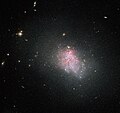Податотека:Violent star formation episodes in dwarf galaxies.jpg

Големина на овој преглед: 635 × 600 пиксели. Други разделности: 254 × 240 пиксели | 508 × 480 пиксели | 813 × 768 пиксели | 1.084 × 1.024 пиксели | 2.168 × 2.048 пиксели | 3.995 × 3.774 пиксели.
Изворна податотека (3.995 × 3.774 пиксели, големина: 10,49 МБ, MIME-тип: image/jpeg)
Историја на податотеката
Стиснете на датум/време за да ја видите податотеката како изгледала тогаш.
| Датум/време | Минијатура | Димензии | Корисник | Коментар | |
|---|---|---|---|---|---|
| тековна | 15:13, 23 октомври 2012 |  | 3.995 × 3.774 (10,49 МБ) | Jmencisom | User created page with UploadWizard |
Употреба на податотеката
Податотекава се користи во следнава страница:
Глобална употреба на податотеката
Оваа податотека ја користат и следниве викија:
- Употреба на ar.wikipedia.org
- Употреба на en.wikipedia.org
- Употреба на fa.wikipedia.org
- Употреба на fr.wikipedia.org
- Употреба на he.wikipedia.org
- Употреба на it.wikipedia.org
- Употреба на zh.wikipedia.org
